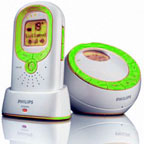Monday 18 June, 2007, 15:31 - Radio Randomness
In a previous entry, I discussed the massive security hole presented to their neighbours like a baboon's bottom, by those still using analogue cordless telephones, as they can be easily received with cheap radio scanners, over quite large distances. However this is as nothing compared to the relatively common practise of bugging one's own house; otherwise known as 'installing a baby monitor'. The majority of these low power (10 mW) transmitters operate using basic analogue FM modulation on frequencies between 49.820 and 49.980 MHz (a low-power, short-range, licence-exempt band in the UK). These devices, like their cordless phone counterparts, can be picked up over several hundred metres, if not further. And whilst the owners often switch off the receivers when their child isn't in range of the monitor, they rarely switch off the transmitter meaning that it's often possible to tune-in to your neighbours going ons all day long (though such activities are strictly illegal in the UK and should not be entered into). Around the wireless waffle HQ, there are several such baby monitors clearly audible on frequencies of 49.830, 49.840, 49.890, 49.930, 49.940, 49.950 and 49.962 MHz (the latter possibly intending to be on 49.960 MHz but is off-tune). There are also carriers on several other frequencies in this range but which are too lost in noise and interference (caused by other transmitters on the same frequency) to clearly make out. Some devices just produce a steady carrier, modulated with audio, others transmit data too, either as a 'warble' every second or so, or as a continous 'chuff-chuff-chuff-chuff' type noise. The latter types typically revert to being audio transmitters once the microphones detect any sound.
Around the wireless waffle HQ, there are several such baby monitors clearly audible on frequencies of 49.830, 49.840, 49.890, 49.930, 49.940, 49.950 and 49.962 MHz (the latter possibly intending to be on 49.960 MHz but is off-tune). There are also carriers on several other frequencies in this range but which are too lost in noise and interference (caused by other transmitters on the same frequency) to clearly make out. Some devices just produce a steady carrier, modulated with audio, others transmit data too, either as a 'warble' every second or so, or as a continous 'chuff-chuff-chuff-chuff' type noise. The latter types typically revert to being audio transmitters once the microphones detect any sound.As well as allowing anyone with a cheap receiver to tune in to your private moments, many of these devices are poorly designed or built and have the capacity to cause significant amounts of interference to nearby radio frequencies, in particular the 6 metre (50 MHz) amateur band. It was as a result of such interference that my attention was drawn to the use of these 49 MHz frequencies in the first place, as reception from around 50.000 to 50.200 MHz suffers from out-of-band emissions from these devices (especially the warble and chuff-chuff-chuff-chuff models). What effect a 200 Watt SSB transmission on 50.150 MHz has on reception on neighbouring devices, I have no idea but it's to be hoped the receivers are as bad as the transmitters and that mummy and daddy are startled to find their 6 month old baby calling 'CQ'.
 It seems that the power supplies used for these transmitters are often badly regulated or smoothed meaning that there's broadband 50 Hz powerline noise, or worse, switch-mode noise emitted along with the intended transmissions.
It seems that the power supplies used for these transmitters are often badly regulated or smoothed meaning that there's broadband 50 Hz powerline noise, or worse, switch-mode noise emitted along with the intended transmissions.There are some newer digital baby monitors available which operate either in the 900 MHz range (US models only, not licenseable in the UK), the 2.4 GHz and 5.8 GHz range. These models are virtually impossible to eavesdrop upon as they use digital modulation and are usually spread-spectrum. That being said, they're not encrypted so I guess it would be possible for some enterprising brainbox to figure out how to listen in, but that's hardly a Sunday afternoon activity (an activity which we do not condone, as it demonstrates utter contempt for people's privacy and is, at least conceptually, even more illegal than listening to the analogue ones). If it were me with a young child, I'd opt for a digital system safe in the knowledge that (a) it offers better features, (b) it's much more difficult to intercept and (c) it causes less noxious emissions that have the capacity to cause severe damage a young humans brain and body tissue. This latter point is exceptionally important, or completely made up, I'm not telling: you decide!
